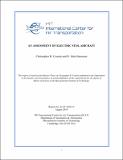AN ASSESSMENT OF ELECTRIC STOL AIRCRAFT
Author(s)
Courtin, Christopher B.; Hansman, R. John
DownloadICAT-2019-13_Courtin_MS Thesis.pdf (19.09Mb)
Metadata
Show full item recordAbstract
Distributed electric propulsion (DEP) is an emerging set of technologies which
enable new vehicle configurations by allowing the efficient distribution of many smaller
propulsors around the airframe. One application of this technology is to greatly enhance
the short takeoff and landing (STOL) capability of a fixed-wing aircraft. STOL aircraft
may have advantages over vertical takeoff and land (VTOL) configurations being
considered for urban passenger transport missions due to lower risk associated with the
certification process and improved performance or reduced weight due to smaller
required propulsion systems. To be useful for these missions, STOL vehicles require
short-field performance competitive with vertical lift configurations.
One pathway to achieving this is by placing many electric motors and propellers
along the leading edge of the wing, an arrangement referred to as a DEP blown wing.
This arrangement increases the effective lift of the wing through interaction of the
propeller slipstream with the trailing edge flap.
Previous blown wing concepts, based on large propellers or turbine engines, were
mechanically complex and adopted only for specialized applications. A DEP blown wing
offers a simpler and potentially more efficient way to enhance the high-lift capability of a
wing, but the performance is not reliably predictable using existing theoretical or
empirical methods.
A wind tunnel test of a representative 2D blown wing section was undertaken, and
section lift coefficient values up to 9 were measured at moderate power settings. The
results of this wind tunnel testing were used to predict the takeoff and landing
performance of reference vehicles with wing and power loading representative of modern
GA aircraft. The results of this analysis suggest that a DEP blown wing may enable
takeoff and landing ground rolls of less than 100 ft. Landing distance over a 50 ft
obstacle is identified as the likely driver of runway requirements for a super-short takeoff
and landing vehicle.
Date issued
2019-09-05Series/Report no.
;ICAT-2019-13